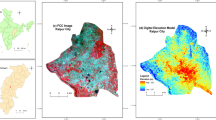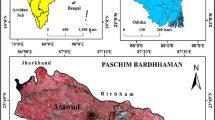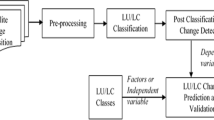Abstract
The knowledge of the surface temperature is important to a range of issues and themes in earth sciences central to urban climatology, global environmental change and human-environment interactions. The study analyses land surface temperature (LST) estimation using temporal ASTER (Advanced Spaceborne Thermal Emission and Reflection Radiometer) datasets (day time and night time) over National Capital Territory Delhi using the surface emissivity information at pixel level. The spatial variations of LST over different land use/land cover (LU/LC) at day time and night time were analysed and relationship between the spatial distribution of LU/LC and vegetation density with LST was developed. Minimum noise fraction (MNF) was used for LU/LC classification which gave better accuracy than classification with original bands. The satellite derived emissivity values were found to be in good agreement with literature and field measured values. It was observed that fallow land, waste land/bare soil, commercial/industrial and high dense built-up area have high surface temperature values during day time, compared to those over water bodies, agricultural cropland, and dense vegetation. During night time high surface temperature values are found over high dense built-up, water bodies, commercial/industrial and low dense built-up than over fallow land, dense vegetation and agricultural cropland. It was found that there is a strong negative correlation between surface temperature and NDVI over dense vegetation, sparse vegetation and low dense built-up area while with fraction vegetation cover, it indicates a moderate negative correlation. The results suggest that the methodology is feasible to estimate NDVI, surface emissivity and surface temperature with reasonable accuracy over heterogeneous urban area. The analysis also indicates that the relationship between the spatial distribution of LU/LC and vegetation density is closely related to the development of urban heat islands (UHI).
Similar content being viewed by others
References
Champion HG and Seth SK (1968) A Revised Survey of Forest Types of India (New Delhi: Government of India Publication)
Gillespie AR (1985) Lithologic Mapping of Silicate Rocks Using TIMS Data Users’ Workshop: JPL Publication, 86(38):29–44
Gillespie A, Shuichi R, Tsuneo M, Steven J, Simon H, and Anne K (1998) A temperature and emissivity separation algorithm for Advanced Space borne Thermal Emission and Reflection Radiometer (ASTER) images. IEEE Transactions on Geosciences and Remote Sensing 36(4):1113–1126
Kant Y and Badarinath KVS (2002) Ground based method for measuring thermal infrared effective emissivities: Implications and perpesctives on the measurement of land surface temperature from satellite data. International Journal of Remote Sensing 23(11): 2179–2191
Kaufmann YJ, Wald AE, Remer LA, Gao BC, Li RR and Flynn L (1997) The MODIS 2.µm Channel-Correlation with visible reflectance for use in remote sensing of aerosol. IEEE Transactions on Geo-science and Remote Sensing 35:1286–1298
Kustas WP and Norman JM (1996) Use of remote sensing for evapotranspiration monitoring over land surfaces. Hydrological Sciences Journal 41:495–516
Owe M and Van de Griend (1994) Ground based measurement on surface temperature and thermal emissivity. Advances in Space Research 14:45–58
Schmugge T, Hook SJ and Coll C (1998) Recovering surface temperature and emissivity from thermal infrared multispectral data. Remote Sensing of Environment 65:121–131
Wan Z, Zhang Y, Zhang Q and Li Z (2002) Validation of the land-surface temperature products retrieved from Terra Moderate Resolution Imaging Spectroradiometer data. Remote Sensing of Environment 83:163–180
Author information
Authors and Affiliations
Corresponding author
About this article
Cite this article
Kant, Y., Bharath, B.D., Mallick, J. et al. Satellite-based analysis of the role of land use/land cover and vegetation density on surface temperature regime of Delhi, India. J Indian Soc Remote Sens 37, 201–214 (2009). https://doi.org/10.1007/s12524-009-0030-x
Received:
Accepted:
Published:
Issue Date:
DOI: https://doi.org/10.1007/s12524-009-0030-x




